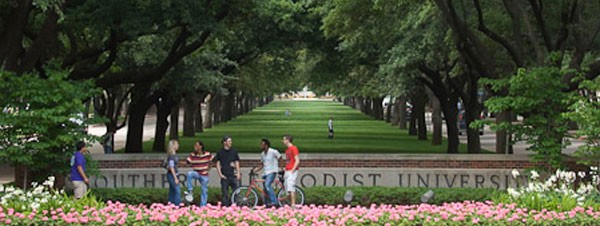North Texas Drought from Trevor Cadigan on Vimeo.


Among the many things SMU is known for are the 232 acres of beautifully maintained landscape. SMU’s Grounds Services plants new grass every season to accommodate for changing weather, and over 3,000 different bulbs and tubers every year to make SMU’s campus vibrant.
But like residents, farmers, and anyone who uses water in North Texas, SMU is dealing with the worst drought to hit the area since the 1950s.
“All I can ask is that students use the sidewalks,” said Brian Martin, senior irrigator for SMU’s grounds services, about the grass most affected by the drought at SMU.
Martin said the areas where football tailgating takes place are some of the areas being affected most.
Martin said the university has had to ask the city of University Park for water variances to sufficiently water new seeds and allow them to grow. After the seeds have germinated, though, water restrictions will resume for those plants.
“We’re just going to have to see how it’s going to work,” said Martin. “I don’t know how well this ryegrass is going to survive after it gets established.”
This September was the driest to date for Dallas Fort Worth, accumulating only a sixth of an inch of rain and causing many cities to enact outdoor burn bans and water restrictions.
So far, the population in Texas affected by the drought is estimated to be almost 13 million, according to the U.S. drought monitor. The Texas Water Development Board has reported Texas reservoirs statewide at only 62 percent full.
North Texas is entering its fifth year of drought conditions, making it one of the worst droughts on record and putting a strain on water supplies for all uses.
“The short-term impacts are an inconvenience,” said WFAA Chief Meteorologist Pete Delkus. “The long-term impacts are things that are really starting to have a serious effect on people’s lives.”
SMU’s water conservation initiative has many programs in place to combat some of the impacts of the drought, including daily monitoring of plumbing leaks around campus and rain water recovery used to water lawns and flowerbeds.
SMU also recovers fin water – condensation – which improves indoor air quality by decreasing mold environments from air-conditioning unit drains and reduces water demand.
Martin said SMU’s grounds services are relying more heavily on the use of drip irrigation to conserve water, as well as using pressure compensating heads that lower the amount of water used during automatic irrigation.
Secretary of SMU’s Environmental Society Jewel Lipps said the most effective way of combatting the drought at SMU would come at the institutional level.
“SMU is shifting toward gray water systems, no water urinals, and water-wise landscaping,” said Lipps, a senior double majoring in environmental science and chemistry. “SMU student opinion, supporting and catalyzing these kinds of institutional changes would be a great step.”
The SMU Environmental Society is a student run organization that encourages life-long environmentally conscious decisions and promotes overall health for the environment.
Some students in the organization, such as Wendy Alyea, a junior double majoring in environmental engineering and chemistry, are also experimenting with aquaponic gardening, which utilizes a fish tank with a soil bank placed above it, creating a self-contained ecosystem that provides food for the fish and nutrients for the plants.
Delkus credits the ongoing drought to spotty rainfall, in which Dallas County is able to collect normal rainfall for a short period of time, followed by an extended period of time with rainfall “well below normal.”
“I think the worst drought conditions statewide are right here, unfortunately, in North Texas,” said Delkus.
There may be a solution to some of the drought problems in the near future, though. Delkus said that this type of weather is very cyclical in North Texas and as this winter approaches so does a storm system called El Niño.
El Niño is a cooling of water in the equatorial pacific, which changes the global weather pattern, causing normally dry places to become wet.
“What that means for us in Texas is above normal precipitation for the winter,” he said. “It also means below normal temperatures.”
Until then, Project Coordinator Yvonne Dupre of Dallas Water Utilities suggests North Texas residents save water in as many ways as they can, including watering by hand instead of using automatic irrigation.
Homes with automatic irrigation systems use 35 percent more water than those without automatic irrigation systems, according to the American Water Works Association.
Dallas County has been under a mandatory twice-per-week maximum watering restriction since December of 2011 when Dallas’ drought contingency plan was enacted to help remedy the effects of the drought.
2011 was the driest year on record for the state of Texas according to the National Weather Service.
Trevor Cadigan is majoring in journalism and minoring in business and Mandarin Chinese. He hopes to attain his MBA in international business.








